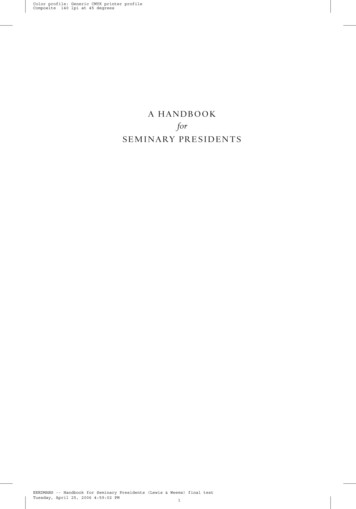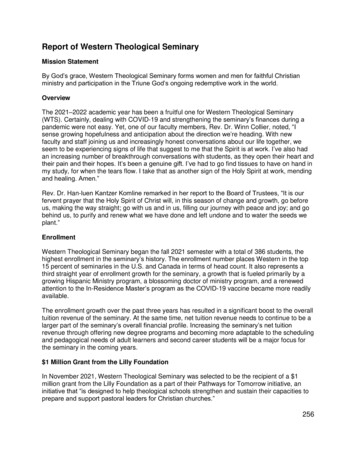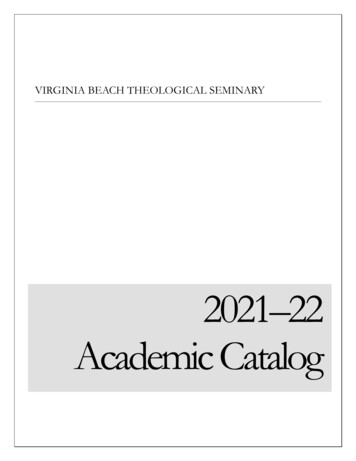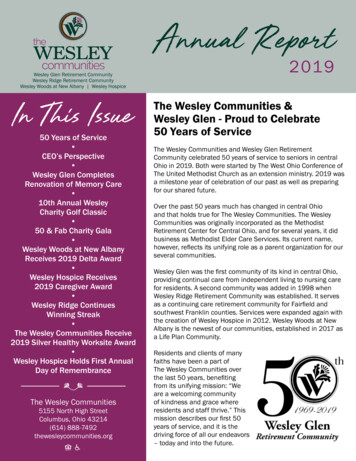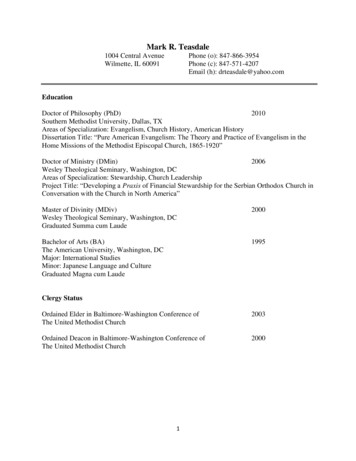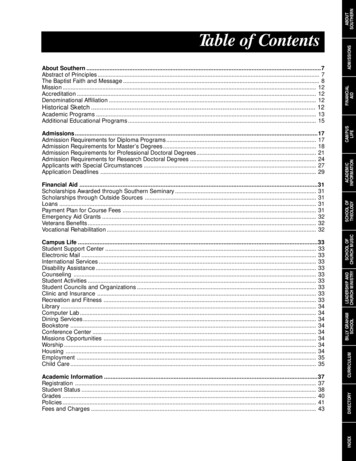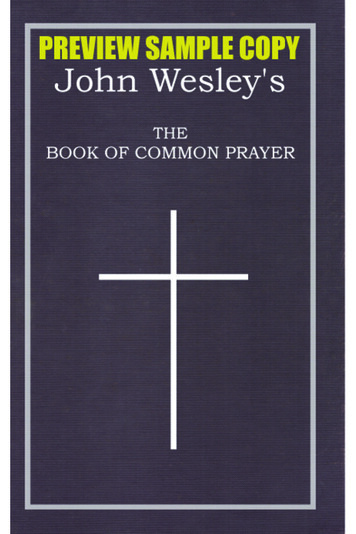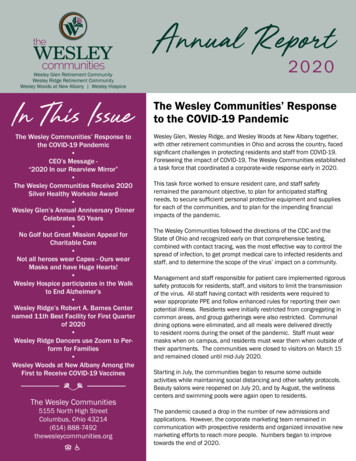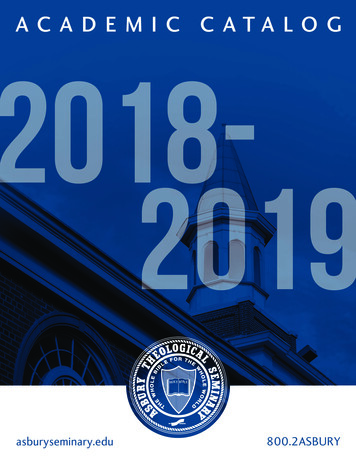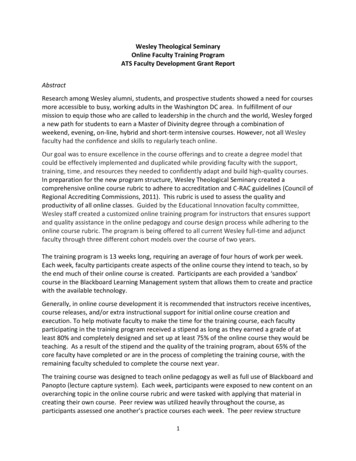
Transcription
Wesley Theological SeminaryOnline Faculty Training ProgramATS Faculty Development Grant ReportAbstractResearch among Wesley alumni, students, and prospective students showed a need for coursesmore accessible to busy, working adults in the Washington DC area. In fulfillment of ourmission to equip those who are called to leadership in the church and the world, Wesley forgeda new path for students to earn a Master of Divinity degree through a combination ofweekend, evening, on-line, hybrid and short-term intensive courses. However, not all Wesleyfaculty had the confidence and skills to regularly teach online.Our goal was to ensure excellence in the course offerings and to create a degree model thatcould be effectively implemented and duplicated while providing faculty with the support,training, time, and resources they needed to confidently adapt and build high-quality courses.In preparation for the new program structure, Wesley Theological Seminary created acomprehensive online course rubric to adhere to accreditation and C-RAC guidelines (Council ofRegional Accrediting Commissions, 2011). This rubric is used to assess the quality andproductivity of all online classes. Guided by the Educational Innovation faculty committee,Wesley staff created a customized online training program for instructors that ensures supportand quality assistance in the online pedagogy and course design process while adhering to theonline course rubric. The program is being offered to all current Wesley full-time and adjunctfaculty through three different cohort models over the course of two years.The training program is 13 weeks long, requiring an average of four hours of work per week.Each week, faculty participants create aspects of the online course they intend to teach, so bythe end much of their online course is created. Participants are each provided a ‘sandbox’course in the Blackboard Learning Management system that allows them to create and practicewith the available technology.Generally, in online course development it is recommended that instructors receive incentives,course releases, and/or extra instructional support for initial online course creation andexecution. To help motivate faculty to make the time for the training course, each facultyparticipating in the training program received a stipend as long as they earned a grade of atleast 80% and completely designed and set up at least 75% of the online course they would beteaching. As a result of the stipend and the quality of the training program, about 65% of thecore faculty have completed or are in the process of completing the training course, with theremaining faculty scheduled to complete the course next year.The training course was designed to teach online pedagogy as well as full use of Blackboard andPanopto (lecture capture system). Each week, participants were exposed to new content on anoverarching topic in the online course rubric and were tasked with applying that material increating their own course. Peer review was utilized heavily throughout the course, asparticipants assessed one another’s practice courses each week. The peer review structure1
ATS Faculty Development Grant ReportWesley Theological Seminaryallowed participants to be exposed to different ideas that they might incorporate into their owncourses. The course was set up to use about 90% of the available tools in Blackboard andPanopto. Participants were exposed to tools in a pedagogical context from the studentperspective and could assess their options of what technology to employ in their own courses.1. What were the primary goals of your faculty development grant project?The training program was 13 weeks long, with the primary goal of training participants inprinciples of designing, facilitating and maintaining an online course. Course objectives were asfollows: Develop familiarity with the elements of an online course and the skills needed tosupport online learning.Identify strategies to effectively use technology to build student engagement andcommunity.Describe and select appropriate technical components for online delivery of theircourse.Evaluate and select assessment methods appropriate to the course and discipline.Create learning materials and content that adheres to Universal Design principles andADA accessibility laws and regulations.Gain confidence and technical skills with Blackboard and Panopto.The training course was first taught in summer 2017 as a hybrid, then fully online in spring2018. About 95% of the participants in the summer 2017 course taught online courses in fall2017 and spring 2018.Wesley students who enrolled in in the online courses that were taught by the trainingparticipants completed course evaluations at the end of fall 2017 at a return rate of 50%-90%.The course evaluations were invaluable in providing information on the effectiveness of theinstructor training and on needs for further change with both the training and the given course.2. How well did the project attain those goals?Judging by participant satisfaction, student course evaluations, the number of online coursesfilled, and students repeatedly opting for the online environment, the training program hasbeen successful and has achieved our initial goals. Student feedback provided areas forimprovement, including further technical training for instructors, procedural changes to helpinstructors better navigate course facilitation, and procedural changes for support staff.The largest complaint from students was that they did not receive feedback in a timely manner.The two instructors who had the most complaints about this agreed that they could have donebetter and felt the training adequately showed the need for quick feedback andcommunication. This helped generate conversation about how to support both faculty andstudents when they get overwhelmed and fall behind.2
ATS Faculty Development Grant ReportWesley Theological Seminary3. What are the most crucial issues and questions engaged by the project?Because of Wesley’s intention to offer more courses online, one of the more crucial issues hasbeen discerning the maximum capacity for online courses and how to support instructorsteaching larger classes online. The instructors who have participated in the training want toconstruct solid, scaffolded learning activities which tend to take more time and require moredetailed feedback. All instructors who participated in the training course and taught onlinehave expressed the need for the maximum capacity to stay below 30 or to have a teachingassistant. However, because our in-person introductory courses tend to have enrollmentsbetween 30-60 students, we can’t simply move a faculty person from the in-person to onlineenvironment without offering additional sections, which requires additional staffing. Thischallenge is the subject of ongoing conversation among faculty and administrators as we seek along-term, sustainable solution.4. What are the most significant opportunities/benefits engaged by the project? How didyou engage them?The greatest opportunity of the project was to expand our online course offerings by helpingfaculty members of all ages, disciplines, and tenures develop their online courses in a safe,supported, but demanding learning environment. In the past, faculty have self-selected toteach online, leading to only a few online courses available and with some inconsistent formatsand standards. With faculty, staff, and administrators committed to offering a more significantrotation of courses online, this training ensured that nearly every faculty member is preparedto offer a high-quality course online that meets seminary (and industry) standards.The peer learning environment also offered many benefits to the faculty. While at times facultyfound it intimidating to review their more senior peers or to be reviewed by each other,throughout each course they found a rhythm that allowed for mutual discovery and greatercollaboration.One significant but unexpected benefit of the training was that instructors now utilizetechnology better and more frequently in their in-person classes. They understand howtechnology can support their pedagogy and permit more flexibility. Several instructorsexpressed that the training caused them to critically assess their past pedagogical habits,leading to better practices in all future classes.5. What are the most significant challenges/obstacles you confronted in the project? Howdid you overcome them?From the beginning, a major concern was adding to faculty load. Many faculty members alreadychoose to teach beyond their faculty load in special tracks or programs, and faculty andadministration alike were concerned about the time commitment to participate in the onlinetraining course. However, offering faculty stipends or course releases and giving them thechoice among three different time periods in which to complete the course overcame thoseconcerns and led to more enthusiastic and committed participation.3
ATS Faculty Development Grant ReportWesley Theological Seminary6. What did you learn of benefit for your school?The greatest benefit to Wesley was having faculty, staff, and administration work together tosolve a complex problem, particularly one that involved faculty capacity and student needs. Itwas essential that the whole community had committed to making a five-year MDiv possiblethrough evening, weekend, and online courses and that a faculty committee, in consultationwith staff and administrators, created the online course rubric to ensure quality and adherenceto standards. As we continue to consider future shifts in theological education, this processoffers a model for how to address critical issues and build a community-wide response.Although it is not a new lesson, this project was a reminder that all faculty need regular learningand developmental activities to expand their repertoire. Often development opportunities areoffered to junior faculty, but in this case, even our most seasoned faculty gained skills andunderstanding that led to improvements in their teaching practices.7. What did you learn that might be of benefit for other schools in the Association? Designing a solid quality assurance rubric for our online courses was essential. We hadto start with a way to measure the quality of online courses. From there, we couldteach how to use that quality assurance rubric from the start, creating positive habits. A balance of pedagogy and technical teaching is important. The first class did not haveas much technical information built into the class, but the in-person sessions allowedmore time for questions and demonstrations. The online class did not have any timefor questions, so questions needed to be answered before they were asked. Athorough ‘how-to’ library of resources including video and pdf was created for theonline course. Training helped faculty understand more pedagogically. When they experienced thetools in a pedagogical context they were able to understand the use far better than justreading about the concept.8. Are there unexpected insights, innovative ideas, or possibilities that have emergedthrough the project? Once faculty understood the technical tools, they were able to better express whatthey wanted those technical tools to do. This helped the educational technologystaff understand and support faculty needs. More instructors now want to explorenew technologies and want to have a voice in future technological adoptions. When looking at the entire educational process from the perspective of an onlinestudent, instructors were able to see things they wanted to change and implementregarding spiritual formation. They had ideas to implement online communitybuilding ranging from an online prayer list to incorporating livestreamed chapelservices and spiritual practices into the online environment. Surprisingly, thisawareness also helped faculty realize that some spiritual/community formation4
ATS Faculty Development Grant ReportWesley Theological Seminary practices were not as integrated into the on-campus experience as they hadpreviously assumed.Video was big! Logically we know this and hear about this, but we had anoverwhelmingly positive student response to the video. We adopted Panopto inJuly 2017. Our instructors were taught how to use it and given basic training invideography, then were given the freedom to use it as they wanted. Best practiceswere offered (e.g. - keeping videos under 20 minutes), and different uses weremodeled in the training class, but instructors were not given strict parameters as tohow videos should look, sound, etc. Instructors tried new things and became adeptat letting their personalities show in the videos. Every online class had positiveratings on a Likert scale and positive, excited comments from students.9. List key recommended practices that you learned in pursuing this project. When developing new programs, ensure that faculty, staff, and administration areworking together to create solutions. Regularly provide incentivized training in new pedagogical methods to all faculty, notjust the newest/greenest. Peer review, and the ability for faculty to see how others are constructing andfacilitating courses, is incredibly helpful for learning and accountability. In online education, as with any new learning environment, clear quality standards andsupports are essential.10. Are there implications from your project for the possible process of redevelopment of theStandards of Accreditation?The biggest implication from our project is the need for emerging technologies, teachingmethods, or distance learning programs to be accompanied by quality assurance standards.11. How might the project or its learning be sustained through a culture of facultydevelopment in your school?Wesley has committed to sustaining this particular project by continuing to offer the trainingcourse as needed for new faculty. (Regular adjuncts are also being invited, without the stipend,in order to strengthen the number and quality of online offerings in Doctor of Ministry tracksand as master’s elective courses.)More broadly, this project provides us with an example for future undertakings. Already facultyare discussing their desire for more technical training in video and podcast production.Additionally, they are seeking ways to provide spiritual formation and community for primarilyonline (or weekend) students. As a result, faculty committees are in conversation with ourtechnology and communications staff about future training opportunities and with chapel andspiritual formation staff and student committees about diversifying opportunities for studentsto engage with community resources.5
ATS Faculty Development Grant ReportWesley Theological SeminaryAdditional question for the final report:1. What are resources that you used beyond those in your institution (people,institutions, materials, etc.)? Please include them with a candid evaluation of theireffectiveness. Please indicate if you are willing to share information about thosepositively evaluated for the benefit of other schools within the Association. We willnot share resources receiving negative evaluations, but those evaluations are helpfulfor our own planning for future projects.We used no outside resources.Wesley Seminary uses Blackboard as the Learning Management system, and Panopto as theVideo management system. These are both contracted systems for 3 years.Our Educational Technology Director strived to utilize only systems and technology already inplace that would be supported technology for instructors when teaching.ReferencesCouncil of Regional Accrediting Commissions. (2011, February). Interregional Guidelines for theEvaluation of Distance Education Programs (Online Learning). Philadelphia, PA.6
In preparation for the new program structure, Wesley Theological Seminary created a comprehensive online course rubric to adhere to accreditation and C-RAC guidelines (Council of Regional Accrediting Commissions, 2011). This rubric is used to assess the quality and productivity of all online classes.
